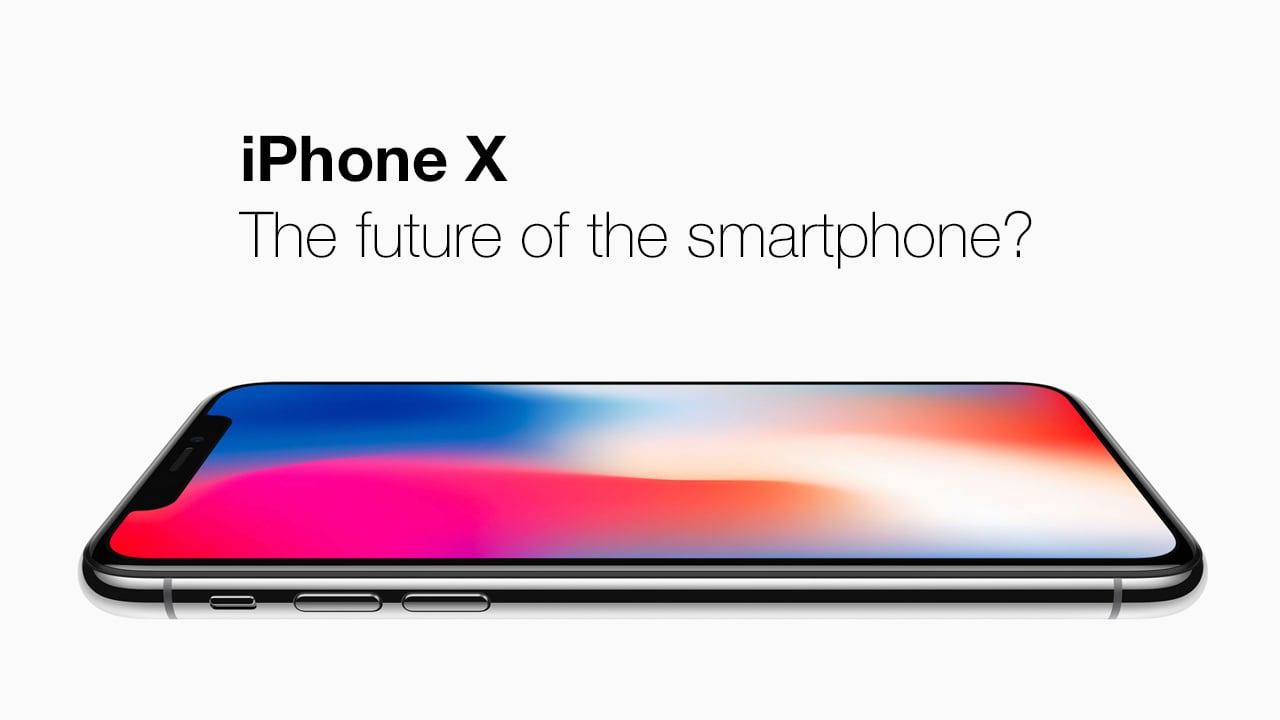
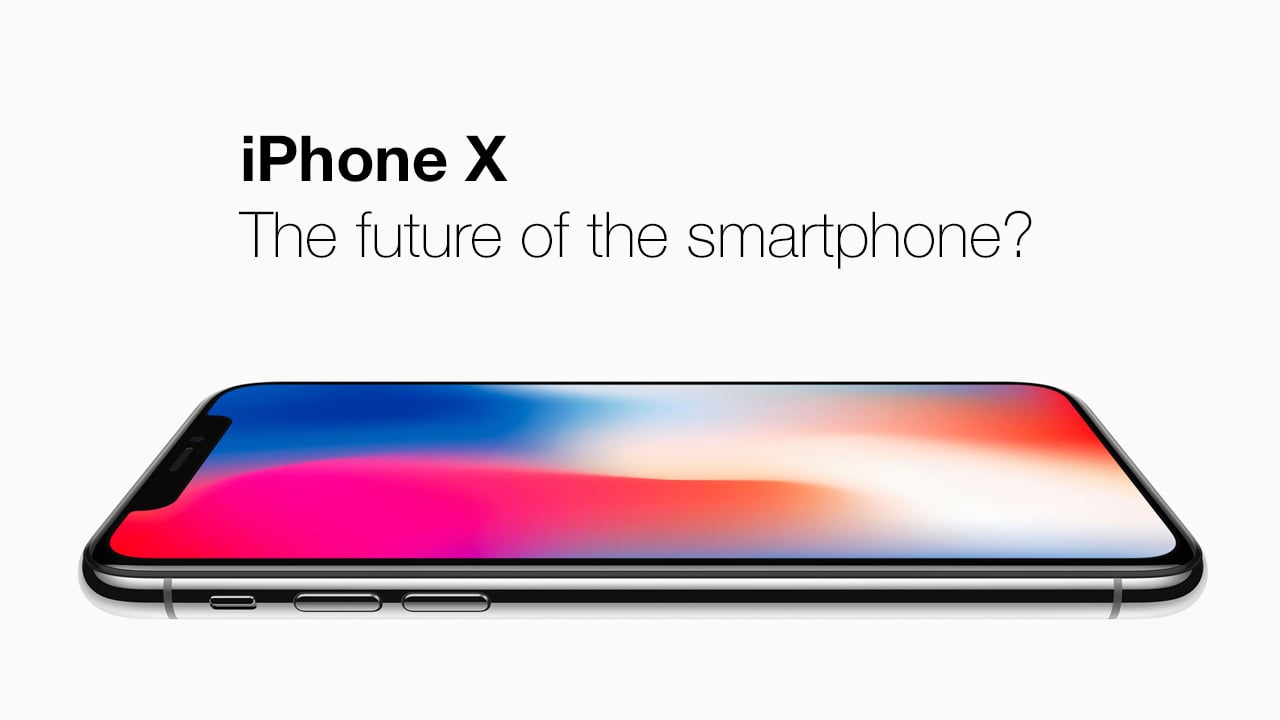 Does the iPhone X represent a paradigm shift in phone design?
Does the iPhone X represent a paradigm shift in phone design?
This is what the future feels like, the iPhone X is finally here. Apple may have been accused of coasting by some in recent years. However, in what turned out to be a major event, even by Apple's standards, its latest keynote showed that the company is surging forward, with many of the innovations potentially game changing.
iPhone X
iPhone X unlocks with a glance. Look away or have your eyes closed and it locks. Open your eyes, even in pitch dark, and it unlocks. Emoji are now Animoji which animate to reflect your expression. Why not send a voice message with a unicorn’s 3D animated face? Or have an Eyes Wide Shut-style Snapchat mask seamlessly animated across your face in a spookily realistic video selfie.
Tim Cook introduced iPhone X as setting out a vision for the next ten years just as the original iPhone did back in 2007. A new premium model above this year’s 8 and 8 Plus.
Technically speaking, that’s a hard sell from what we know so far. iPhone X is basically the latest iteration of the iPhone line - with the exact same six-core A11 chip as in the iPhone 8 - wrapped in a stylish new chassis with some advanced front facing sensors and a slightly more advanced camera system (most notably with optical image stabilisation on both rear cameras.)
Its defining feature today is the edge-to-edge HDR OLED screen. A 5.8-inch screen that’s bigger than the iPhone 8’s 5.5-inch screen in a form factor only marginally taller, wider and deeper than a standard iPhone 8.
Just as with the Galaxy 8’s Infinity Display, it’s a stunning design element and Apple went through an unexpectedly prosaic demo of how cool the Internet and photos, videos etc. looked on a near edge-less display. In terms of specs, the screen has a resolution of 2,436x1,125 with 458ppi (Super Retina HD) compared 1,334x750 (326ppi) and 1,920x1080 (401ppi) for 8 and 8 Plus. Galaxy is higher still with 2960 x1440 at 571 ppi, but as Sony argued with VENICE - pixels are no longer the key metric. The HDR implementation on iPhone X is stunning and it’ll be interesting to see comparative lab reports.
Another point of comparison with Samsung is that while the Galaxy uses black bezels to minimise the visual impact, the iPhone X’s polished metal consciously evokes the chrome edges of the original iPhone. (iOS 11 itself provides another callback with new high res Planet Earth wallpapers reminiscent of the first iPhone.) After years of rather same-y undistinguished iPhones, X is distinctly different from other iPhones and the competition.
While Samsung were first with the Infinity Display approach, they failed to integrate fingerprint sensing into the touchscreen and made do with an awkwardly placed sensor on the back, plus unimpressive face detection that was quickly spoofed with a photograph.
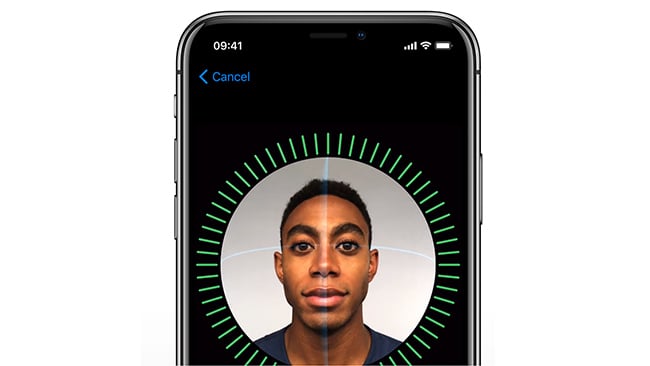
Facial recognition has been tried before. Has Apple finally nailed it?
Face ID and revised interface
Apple have been bolder in removing the TouchID sensor entirely and instead rely upon Face ID. This facial recognition system uses a sophisticated cluster of sensors at the top of iPhone which includes an IR camera.
A thousand people or so worked on the system world-wide, ensuring it should cope whether you put on glasses, change your hairstyle or grow a beard. The system tracks 30,000 3D data points on your face and while Touch ID has a 1 in 50,000 chance of a false match, Face ID is 1 in a million. And if you’ve got an Evil Twin… rely on passcode.
The removal of the home button also requires a tweaked UI - swipe up will now take you home and pause the gesture half-way through to get into multi-tasking. Swipe down from the top on the right to get to Control Centre, on the left for notifications. It will take getting used to, but looks slick and yes, more futuristic than the old home button routine. The lock button by contrast has got bigger, as it now does double duty - double click for Apple Pay.
A big screen in a smaller body and all the advanced sensors would suggest a sharply abbreviated battery life, but Apple insists X will have two more hours battery life per day than a standard iPhone 8. Quite how this wizardry has been achieved wasn’t explained, other than a reference to clever tuning of the hardware/software stack.
Starting at £999 for the 64GB model and cruelly bypassing 128GB for a top tier £1149 256GB, iPhone X sets a new benchmark for premium pricing. Part of this is Brexit currency exchange, but the reality is that OLED screens are in short supply with only one manufacturer - Samsung - able to provide the necessary quality in limited quantity. Pre-orders don’t start until October 27 - over a month after the 8 - and undoubtedly constrained shipments on November 3rd.
The meaning of X
Apple have worked miracles with iPS LCD technology, regularly gaining stellar marks for colour accuracy. So why make the switch?
With deeper blacks, OLEDs undoubtedly provide vivid images and Apple has a clever new software system to hopefully prevent the burn-in effect which can be one of the drawbacks.
OLED has also become the favoured technology for VR due to its fast-switching, so less blurriness, less motion sickness. This and the prominence given to ARKit at WWDC led many to believe AR would be a centrepiece of this year’s iPhone sales pitch.
In fact, AR time was limited - a new game or two during the iPhone 8 reveal, some clever super-imposition of player stats layered upon real world sports footage. A promo video featured an obligatory rampaging T-Rex in a real world setting, but there was no hint of an Apple equivalent to Samsung’s Gear VR headset.
Apple has leveraged its integrated hardware/software stack to pole-vault into a leadership role with ARKit, perhaps a year ahead of Google despite their longer public experimentation and new ARCore rival system.
With iPhone X, it’s built a premium platform for AR but part of that 10-year vision is the patience to wait for the apps and perhaps additional hardware to best exploit it.
iPhone 8 & 8 Plus
Following the usual cadence, this should be the year of the S models - an unchanged form factor with ramped up internals. However, just as the 7 and 7 Plus essentially iterated on the smash-hit 2014 large screen designs, so the 8 and 8 Plus keep to the same look and dimensions, but swap out the aluminium back in favour of glass so as to support wireless charging.
The iPhone 4 introduced the metal and glass approach, but this time around the glass is the most durable yet with new space grey, silver and gold finishes matching the aluminium band for a seamless appearance. As with last year’s models, they’re water and dust resistant. The stereo speakers are now 25% louder with better bass, while the screen features the True Tone technology introduced with the iPad Pros - dynamically matching screen tone to ambient lighting.
The cameras feature more iterative improvements with a more advanced 12MP camera. The 8 and 8 Plus share an f/1.8 six-element lens with optical image stabilisation (previously exclusive to the Plus model). The 8 Plus is still distinguished from the 8 with a secondary telephoto camera offering optical zoom and Portrait mode.
This year’s version of Portrait mode is once again a beta feature. Portrait Lighting uses the A11 chip and new ISP (Image Signal Processor) to dynamically simulate different lighting situations. The spiel being that just as a professional photographer can ‘sculpt’ the light falling on a subject’s face, so this new mode creates a depth map of a face so as to produce effect such as Natural Light, Studio Light, Contour Light etc. The demo’s and UI looked impressive, of course. In a real world setting, how quickly and easily the modes are to use, how they cope with lighting in the UK rather than California we’ll need to see. The new ISP also enables faster autofocus and, for the first time, hardware enabled multi band noise reduction.
Video offers more straightforward enhancements: 4K video up to 60fps and slow motion in 1080 HD up to 240fps. A larger sensor, with optical image stabilisation and ISP enhancements looks very promising indeed for performance. The ISP features an Apple developed video encoder which apparently does real time analysis of 2 million tiles per second to best optimise h.265 encoding.
In addition, all the iPhone 8 models have cameras that are tuned for AR applications. A new game called The Machines was demo’d on staging with the player manoeuvring around a virtual 3D table top to guide their sci-fi troops into battle. A multi-player game, either locally or online, it boasted impressive visuals but we are obviously very early into AR gaming generally.
The A11 chip shared with iPhone X is a beast. It’s six core, up from four last year, with two high power and four high efficiency cores. The latter are 70% faster than last year’s equivalent cores with the A11 as a whole being 25% faster than A10. It’s also paired with the first ever Apple designed GPU, a three-core design which is optimised to support Metal 2, which not only means faster 3D games, but also supports machine learning and neural networks such as are used with Face ID.
For pricing, the entry-level now starts at 64GB rather than 32GB but that means £699 rather than £599 last year (blame currency rates for half of that increase). The 8 Plus also starts at 64GB, but the £799 compares a bit better to last year’s £719.
Preorders begin this Friday and will ship on the 22nd.
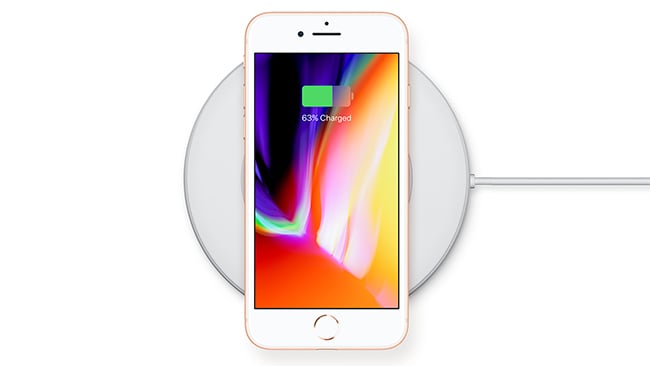
Wireless charging finally makes it to the iPhone series
Wireless Charging & AirPods Update
Despite the addition of wireless charging to this year’s iPhones, Apple isn’t shipping a charger itself. At least not yet.
Apple is instead supporting the Qi standard rather than a proprietary solution. The reason being a key advantage of wireless charging should be quick top-ups at airports or restaurants with open standard charging mats. Existing (and relatively cheap) Qi chargers for Android should work fine with the new iPhones.
However, there was also a Sneak Peak at a 2018 product called AirPower. This is based on Qi technology, but enhanced by Apple so a single charging matt could handle your iPhone, Apple Watch and AirPods. It looks super-convenient, isn’t possible with current technology and Apple will share its enhancements with Qi to move the standard forward for all.
This wireless charging vision was added to with news of a new charging case for the AirPods with support for wireless charging and an external rather than internal LED indicator. The AirPods themselves don’t seem to be changed in spec and it wasn’t clear when upgraded units would be available.
Apple Watch Series 3
The Apple Watch gains independence from iPhone with its own LTE cellular connection via an embedded electronic SIM card and an antenna built into the watch face.
In design terms, the look remains unchanged from the original 2014 design but the LTE model is distinguished by a red crown on the Digital Crown, a design detail that first appeared with the short lived Apple Watch Edition gold model. There’s also some new watch faces, an analogue display being showcased that has dots to represent signal strength.
To show off the potential of cellular, they had a presenter making a phone call from the middle of a lake, however the promotional ad actually focused on the benefits of being able to stream Apple Music via cellular wherever you are. The music app is radically enhanced to support this.
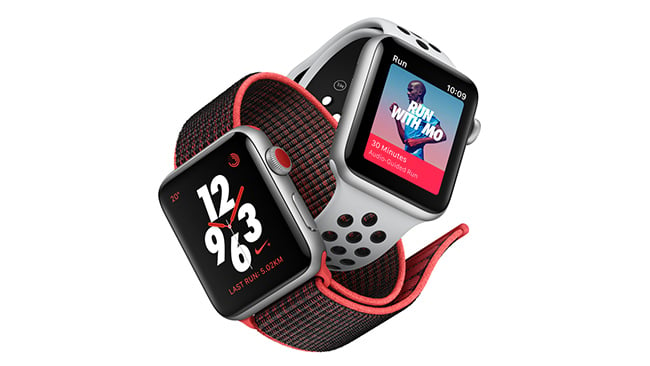
The new Apple Watch 3 features numerous additional capabilities
As the Apple Watch LTE is reliant on an electronic sim, launch countries and partners are limited. In the UK, it’s just EE who perhaps not coincidentally have a promotion now to stream Apple Music without eating into your data allowance. The Apple Watch will share the same phone number as your iPhone and we’ll have to see what the deals will be for combined packages. In the US its $10 extra per month with AT&T.
Aside from cellular, Apple Watch Series 3 features a new dual core processor with 70% higher performance than previous model, plus a new W2 chip for 85% faster WiFi. A barometric altimeter has been added while there’s now a ceramic grey model. In addition, Series 3 gives Siri the ability to talk for the first time rather than responding to your requests on screen only. Battery life stays at 18 hours for all day usage.
Pricing for Series 3 starts at £329/£359 38/42mm with cellular equivalents being £399/£429. The cellular model also benefits from having double the storage of the standard 8GB.
Series 2 is being discontinued immediately, so look out for good deals with resellers, while Series 1 is retained as the entry level in aluminium only.
Apple TV supercharges 4K HDR with iTunesFor 4K enthusiasts
Apple pulled off a coup with the news that not only would the new Apple TV support 4K HDR content but pricing would be the same as for HD and any existing HD purchases get a 4K upgrade for free with several major Hollywood studios (Disney are one notable exception.)
Apple also promised support for 4K for streaming apps from third-parties.
Video output is 2160p with Dolby Vision and HDR10, plus HDMI 2.0 and Gigabit Ethernet.
Internally, the new chipset is now based on the A10X powerhouse used in this year’s iPad Pros and has 3GB of RAM. To show this off, longtime Sony PlayStation collaborator thatgamecompany unveiled a new Journey-esque game called Sky. Due out soon it had the company’s customary graphical flair and will also, unsurprisingly, be coming to iPhone and iPad as well as Apple TV.
Apple TV 4K will be available to order from September 15, shipping on the 22nd with £179 for the 32GB version (up from £139 from existing HD model) and £199 for 64GB.
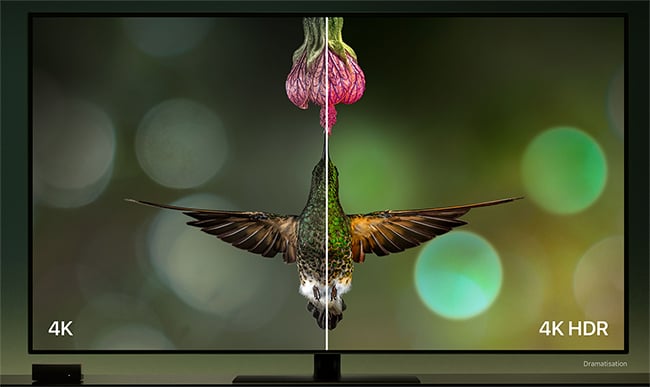
The Apple TV makes the move to both 4K and HDR in one go
Conclusion
During its development, iPhone X was called D22 or more evocatively Ferrari. The mainstream iPhone has built a reputation as the BMW of smartphones, expensive but with performance to match. X is something else.
X has a special meaning for Apple fans thanks to OS X of course, but X is also favoured as a naming convention for experimental aircraft. Some Apple innovations such as the original MacBook Air and MacBook Pro with Retina screen have redefined their respective categories, others such as the 2013 MacPro went back to the drawing board.
One reason to suspect Face ID really is just the start of something much bigger - the underlying technology owes much to PrimeSense which Apple acquired in 2013. PrimeSense had previously been notable for the technology in Kinect - the motion sensing add-on for Xbox that was briefly one of the fastest selling consumer tech items in history. XBox One was originally a showcase for gesture-driven TV and reading that same vision across to Apple in a year or two is worth considering. Anyone with an iPad knows how quickly the screen gets smeared with fingerprints - could gestures be introduced there? What about MacBooks? Maybe iPhone X really is a hint of what’s to come…
iPhone X aside, this was a polished presentation in the new Steve Jobs Theatre which began with a touching tribute to his vision. And there was a lot of impressive work on show, with Apple Watch’s health aspects - such as an updated heart rate monitor app with alerts for irregular rhythms - deserving particular respect. It was also a presentation that throughout leant on short video clips to deliver messaging in fun, impactful sequences. Apple Watch again scored highly here, cross-cutting between a wide variety of users telling their stories in touching and witty fashion. It may have taken a weekend leak to get the spotlight back on Apple, but it was an impressive showing that deserved the attention.
Tags: Technology


Comments